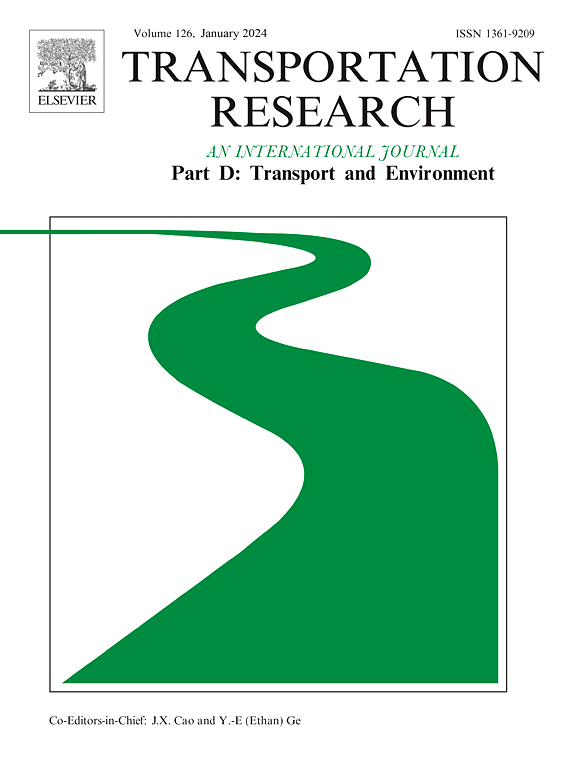沥青对环境生命周期的影响:系统回顾和新的加拿大模型
IF 7.3
1区 工程技术
Q1 ENVIRONMENTAL STUDIES
Transportation Research Part D-transport and Environment
Pub Date : 2024-10-18
DOI:10.1016/j.trd.2024.104439
引用次数: 0
摘要
沥青(或称沥青粘结剂)是造成路面环境影响的主要因素。然而,文献中关于沥青粘结剂的生命周期评估却寥寥无几,且结果千差万别。为了更好地了解沥青对环境的影响,我们回顾了 2024 年之前发表的生命周期评估。然后,我们使用 TRACI 2.1 和 ecoinvent v3.6 为不同的加拿大市场建立了沥青生命周期评估模型。加拿大沥青粘结剂的碳足迹范围为 [826-1098] kgCO2eq/t(如果包括散逸性排放,则可能高达 2680 kgCO2eq/t)。原油开采是大多数生命周期环境影响类别的主要贡献者,但很可能仍被低估。运输影响可能差异很大(加拿大为 [18-291] kgCO2eq/t)。这两个热点地区的模型必须量身定制。最后,我们严格比较了所有已公布的原生沥青胶结料生命周期评估的碳足迹:以前的碳足迹范围在 [143-637] kgCO2eq/t 之间,很可能被低估了。必须对以前的路面生命周期评估结果提出质疑,并紧急开发更高质量的生命周期影响指标,以提出基于生命周期评估的路面绿色实践的区域化建议。本文章由计算机程序翻译,如有差异,请以英文原文为准。
Environmental life-cycle impacts of bitumen: Systematic review and new Canadian models
Bitumen − or asphalt binder − is a major contributor to pavement environmental impacts. Nevertheless, the literature only counts scarce asphalt binder LCAs, with highly variable results. To better understand bitumen environmental impacts, we review LCAs published before 2024. Then, we build bitumen LCA models for different Canadian markets, using TRACI 2.1 and ecoinvent v3.6. The carbon footprint of Canadian asphalt binders ranges within [826–1098] kgCO2eq/t (potentially up to 2680 kgCO2eq/t when including fugitive emissions). Crude oil extraction is the main contributor to most life cycle environmental impact categories, but likely still underestimated. Transportation impacts can vary highly ([18–291] kgCO2eq/t in Canada). Models for these two hotspots must be tailored. Finally, we critically compare the carbon footprints of all published virgin asphalt binders LCAs: previous carbon footprints range within [143–637] kgCO2eq/t and are very likely underestimated. Previous pavement LCA results must be questioned, and higher-quality LCIs urgently developed to produce robust regionalized LCA-based recommendations on pavement green practices.
求助全文
通过发布文献求助,成功后即可免费获取论文全文。
去求助
来源期刊
CiteScore
14.40
自引率
9.20%
发文量
314
审稿时长
39 days
期刊介绍:
Transportation Research Part D: Transport and Environment focuses on original research exploring the environmental impacts of transportation, policy responses to these impacts, and their implications for transportation system design, planning, and management. The journal comprehensively covers the interaction between transportation and the environment, ranging from local effects on specific geographical areas to global implications such as natural resource depletion and atmospheric pollution.
We welcome research papers across all transportation modes, including maritime, air, and land transportation, assessing their environmental impacts broadly. Papers addressing both mobile aspects and transportation infrastructure are considered. The journal prioritizes empirical findings and policy responses of regulatory, planning, technical, or fiscal nature. Articles are policy-driven, accessible, and applicable to readers from diverse disciplines, emphasizing relevance and practicality. We encourage interdisciplinary submissions and welcome contributions from economically developing and advanced countries alike, reflecting our international orientation.

 求助内容:
求助内容: 应助结果提醒方式:
应助结果提醒方式:


